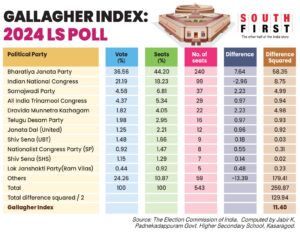India’s Gallagher index reduced to 11.40 in 2024, signifying an improvement in the representative character of India’s electoral system.
Published Jun 13, 2024 | 2:00 PM ⚊ Updated Jun 13, 2024 | 3:10 PM

Prime Minister Narendra Modi taking the oath. (X)
Since the present First-Past-the-Post system in India adequately reflects the vote share in the seat tally, switching over to Proportional Representation is not an absolute necessity.
The Gallagher Index, invented by Michael Gallagher, an Irish political scientist, is a measure used in psephology to quantify the discrepancy between the percentage of votes a party receives in an election and the percentage of seats awarded in the resulting legislative body.
It is used to assess an electoral system’s proportionality and representative character. The lower the Gallagher Index, the more proportional the system is.
Computing the Gallagher index involves taking the square root of half the sum of the squares of the difference between per cent of the votes and per cent of seats for each political party. The division by 2 gives an index whose values range between 0 and 100.
The larger the differences between the percentage of votes and the percentage of seats summed over all parties, the larger the Gallagher index. The larger the index value signifies the greater disproportionality and vice versa.
Michael Gallagher’s Election Systems website, maintained by the Department of Political Science, Trinity College, Dublin, marked India’s Gallagher Index as 16.06 in 2019 and 17.53 in 2014, remarkably high compared with the EU’s 7.87 (2019) and the United States’ 0.82 (2022).
India’s Gallagher index dwindled to 11.40 in 2024. It signifies an improvement in the representative character of India’s electoral system (See the table).

The Gallagher Index is based on 2024 Lok Sabha results; Vote %age on an all-India basis.
Related: Election results reality check for BJP
Prannoy Roy and Dorab R Sopariwala, in their book, The Verdict: Decoding India’s Elections (2019), have observed that India now has what could be called a ‘jugaad’ first-past-the-post (FPTP) system with several characteristics of the proportional representation system. The key characteristic is that the percentage of seats won by various parties roughly corresponds with their percentage of votes.
They opine that India’s unique Jugaad FPTP system has the best of both FPTP and Proportional Representation systems. Over time, the Indian Jugaad FPTP system has converted Lok Sabha elections into a more equal, quasi-proportional representation system.
In India’s newly emerged Jugaad FPTP system, the regional parties win many more seats in proportion to their vote share owing to the geographical concentration of their votes. The Samajwadi Party, the All India Trinamool Congress, the Dravida Munetra Kazhakam, and the Telugu Desam Party have bagged higher seats than their vote share.
The DMK won an impressive 4.05 percent of seats with their moderate 1.82 percent votes (calculated as part of the national vote share). The Jugaad FPTP system favours regional parties more than national parties. In 2002-2019, with a one per cent vote, the national parties bagged only 7 seats in the Lok Sabha, whereas the regional parties took 11 seats.
The FPTP system has many merits in its favour. It is simple for voters to understand. In countries like India with such a low literacy rate, the alternative voting system like Party-list PR can defy easy understanding. The FPTP system generally delivers a clear majority for one party or alliance, whereas Proportional Representation usually delivers a fractured result that leads to severe political instability.
Under FPTP, MPs serve the constituency they campaign in. This makes them more inclined to tackle important local issues. The adoption of PR by the List System weakens the link between the elected representative and his constituency. Voters have no ability to determine the identity of the person who will represent them and no identifiable representative for their locality, nor do they have the ability to easily reject an individual if they feel he has behaved poorly in office.
Israel is a textbook example of the mischief that the PR system would deliver. Israel’s List PR system was so proportional that it resulted in a large multi-party system with a very fragmented parliament. One result is that for decades, Israel experienced difficulties in building and maintaining large coalition governments, often containing several small and more extreme parties, which can and do yield blackmail powers.
The 2018–2022 period, an era of political instability in Israel, witnessed five Knesset snap elections held in less than four years. Since the late 1990s, the various governments in Israel have rested on a narrow coalition majority, thus increasing the bargaining power of the fringe parties in the coalition against the mainstream party.
The bottom line is that with a diminished Gallagher Index reflecting an improved representative character of India’s electoral system and a Jugaad FPTP system in working that combines the merits of both FPTP and Proportional Representation systems, India may be better off continuing with the present FPTP system rather than switching over to a more perilous Proportional Representation system.
As the present Jugaad FPTP system adequately reflects the popular vote in seat tally, introducing the Mixed Member Proportional Representation (MMRP) system is unwarranted in India.
(Faisal CK is Deputy Law Secretary to the Government of Kerala. Views are personal.)
(South First is now on WhatsApp and Telegram.)
